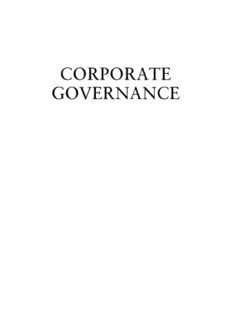Table Of ContentCORPORATE
GOVERNANCE
The Robert W. Kolb Series in Finance provides a comprehensive view of the field
of finance in all of its variety and complexity. The series is projected to include
approximately65volumescoveringallmajortopicsandspecializationsinfinance,
rangingfrominvestments,tocorporatefinance,tofinancialinstitutions.Eachvol-
umeintheKolbSeriesinFinanceconsistsofnewarticlesespeciallywrittenforthe
volume.
EachKolbSeriesvolumeiseditedbyaspecialistinaparticularareaoffinance,who
develops the volume outline and commissions articles by the world’s experts in
thatparticularfieldoffinance.Eachvolumeincludesaneditor’sintroductionand
approximatelythirtyarticlestofullydescribethecurrentstateoffinancialresearch
andpracticeinaparticularareaoffinance.
Theessaysineachvolumeareintendedforpracticingfinanceprofessionals,grad-
uatestudents,andadvancedundergraduatestudents.Thegoalofeachvolumeis
toencapsulatethecurrentstateofknowledgeinaparticularareaoffinancesothat
thereadercanquicklyachieveamasteryofthatspecialareaoffinance.
CORPORATE
GOVERNANCE
A Synthesis of Theory,
Research, and Practice
Editors
H. Kent Baker
Ronald Anderson
TheRobertW.KolbSeriesinFinance
JohnWiley&Sons,Inc.
Copyright(cid:2)c 2010byJohnWiley&Sons,Inc.Allrightsreserved.
PublishedbyJohnWiley&Sons,Inc.,Hoboken,NewJersey.
PublishedsimultaneouslyinCanada.
Nopartofthispublicationmaybereproduced,storedinaretrievalsystem,or
transmittedinanyformorbyanymeans,electronic,mechanical,photocopying,
recording,scanning,orotherwise,exceptaspermittedunderSection107or108ofthe
1976UnitedStatesCopyrightAct,withouteitherthepriorwrittenpermissionofthe
Publisher,orauthorizationthroughpaymentoftheappropriateper-copyfeetothe
CopyrightClearanceCenter,Inc.,222RosewoodDrive,Danvers,MA01923,
(978)750-8400,fax(978)646-8600,orontheWebatwww.copyright.com.Requeststo
thePublisherforpermissionshouldbeaddressedtothePermissionsDepartment,
JohnWiley&Sons,Inc.,111RiverStreet,Hoboken,NJ07030,(201)748-6011,
fax(201)748-6008,oronlineathttp://www.wiley.com/go/permissions.
LimitofLiability/DisclaimerofWarranty:Whilethepublisherandauthorhaveused
theirbesteffortsinpreparingthisbook,theymakenorepresentationsorwarrantieswith
respecttotheaccuracyorcompletenessofthecontentsofthisbookandspecifically
disclaimanyimpliedwarrantiesofmerchantabilityorfitnessforaparticularpurpose.No
warrantymaybecreatedorextendedbysalesrepresentativesorwrittensalesmaterials.
Theadviceandstrategiescontainedhereinmaynotbesuitableforyoursituation.You
shouldconsultwithaprofessionalwhereappropriate.Neitherthepublishernorauthor
shallbeliableforanylossofprofitoranyothercommercialdamages,includingbutnot
limitedtospecial,incidental,consequential,orotherdamages.
Forgeneralinformationonourotherproductsandservicesorfortechnicalsupport,
pleasecontactourCustomerCareDepartmentwithintheUnitedStatesat(800)762-2974,
outsidetheUnitedStatesat(317)572-3993orfax(317)572-4002.
Wileyalsopublishesitsbooksinavarietyofelectronicformats.Somecontentthat
appearsinprintmaynotbeavailableinelectronicformats.Formoreinformationabout
Wileyproducts,visitourWebsiteatwww.wiley.com.
LibraryofCongressCataloging-in-PublicationData:
Corporategovernance:asynthesisoftheory,research,andpractice/H.KentBakerand
RonaldAnderson,editors.
p.cm.–(TheRobertW.Kolbseriesinfinance)
Includesindex.
ISBN978-0-470-49913-9(cloth)
1.Corporategovernance. 2.Industrialmanagement. I.Baker,H.Kent(HaroldKent),
1944– II.Anderson,Ronald.
HD2741.C774682010
338.6–dc22
2010010864
PrintedintheUnitedStatesofAmerica
10 9 8 7 6 5 4 3 2 1
Contents
Acknowledgments ix
PART ONE Background and Perspectives on
Corporate Governance 1
History, Systems, Best Practices, and Empirical Evidence
1 AnOverviewofCorporateGovernance 3
H.KentBakerandRonaldAnderson
2 TheFinancialDeterminantsofAmericanCorporate
Governance:ABriefHistory 19
LawrenceE.MitchellandDaliaT.Mitchell
3 CorporateGovernanceSystems 37
ChristianAndres,AndreBetzer,MarcGoergen,andDanielMetzger
4 CorporateGovernanceBestPractices 57
AlexTodd
5 What’sWrongwithCorporateGovernance
BestPractices? 79
ChristopherSørenShannTurnbull
6 TheEffectofCorporateGovernanceonPerformance 97
SanjaiBhagat,BrianBolton,andRobertaRomano
7 InternationalCorporateGovernanceResearch 123
DianeK.Denis
Separation of Ownership and Control
8 AgencyTheory:IncompleteContractingand
OwnershipStructure 141
IainClacher,DavidHillier,andPatrickMcColgan
9 TheoriesandModelsofCorporateGovernance 157
ThomasW.Joo
v
vi Contents
10 Unfettered Agents?TheRoleofEthicsin
CorporateGovernance 175
DonaldNordberg
PART TWO Internal Governance 193
Boards of Directors
11 BoardCompositionandOrganizationIssues 195
MatteoTonello
12 BoardDiversity 225
DanielFerreira
13 BoardSubcommitteesforCorporateGovernance 243
ZabihollahRezaee
Compensation, Ownership, and Turnover
14 ExecutiveCompensation:Incentives
andExternalities 263
PhilippGeilerandLucRenneboog
15 CompensationConsultantsandExecutivePay 285
MartinJ.Conyon
16 CorporateGovernanceandOwnershipStructure 303
JohnJ.McConnell,StephenB.McKeon,andWeiXu
17 TheEffectsofManagementTurnoveron
FirmPerformance 323
MarkR.HusonandRobertParrino
PART THREE External Governance 345
Nonexecutive Shareholders
18 CorporateMonitoringbyBlockholders 347
IsabelleDherment-Fe´re`reandLucRenneboog
19 TheGovernanceofFamilyFirms 371
MortenBennedsen,FranciscoPe´rez-Gonza´lez,andDanielWolfenzon
20 InstitutionalandOtherShareholders 391
ChrisMallin
21 ThePoliticsofShareholderActivism 409
DonaldNordberg
CONTENTS vii
Nonequity Stakeholders
22 ExecutiveBehavior:ACreditorPerspectiveon
ManagerialOwnership 427
RonaldAnderson,SattarMansi,andDavidReeb
23 GovernanceofBankingInstitutions 451
Rene´eBirgitAdams
24 CorporateGovernance:NonequityStakeholders 469
MarcGoergen,ChrisBrewster,andGeoffreyWood
Proxy Contests and Markets
25 ProxyContests 497
PeterG.Szilagyi
26 CorporateTakeoversandRestructurings 517
MikeStegemoller
27 CorporateTakeoversandWealth Creation 535
MarinaMartynovaandLucRenneboog
Accounting, Legal, and Regulatory Intervention
28 CorporateGovernanceandAccountability 559
ReneeM.Jones
29 CorporateGovernanceRulesandGuidelines 577
ZabihollahRezaee
30 EconomicsAspectsofCorporateGovernance
andRegulation 599
ValentinaBrunoandStijnClaessens
PARTFOUR AnswerstoChapterDiscussionQuestions 621
Index 663
Acknowledgments
This book represents an ensemble of players, each providing unique con-
tributions. Corporate Governance would not have been possible without the
outstanding work of dozens of scholars and practitioners who wrote the
chapters.Weparticularlyandgratefullyacknowledgetheirdiligentworkinpro-
viding multiple revisions of each chapter. The book benefited substantially from
thecapableeditorialassistanceofMeghanNesmith,whopainstakinglyreviewed
thechaptersandmademanysubstantivesuggestions.Wethankourtalentedpub-
lishing team at John Wiley & Sons, including Laura Walsh, Jennifer MacDonald,
MichaelLisk,andmanyothers.WeappreciatethesupportprovidedbyBobKolb,
theserieseditor,throughouttheprocessofproducingthisbook.Wealsowantto
recognizethesupportprovidedbytheKogodSchoolofBusinessAdministrationat
AmericanUniversity,especiallyDeanRichardDurandandSeniorAssociateDean
Kathy Getz. Finally, we are indebted to our friends and families, who have been
silentpartnersinthiseffortandhavehelpedtomakethisprojectpossible.Linda
Bakerdeservesspecialthanksforherpatience,support,andediting.
ix
Corporate Governance: A Synthesis of Theory, Research, and Practice
Edited by H. Kent Baker and Ronald Anderson
Copyright © 2010 JohnWiley & Sons, Inc.
PART ONE
Background and Perspectives
on Corporate Governance
History,Systems,BestPractices,andEmpiricalEvidence
Chapter1. AnOverviewofCorporateGovernance 3
Chapter2. TheFinancialDeterminantsofAmericanCorporate
Governance:ABriefHistory 19
Chapter3. CorporateGovernanceSystems 37
Chapter4. CorporateGovernanceBestPractices 57
Chapter5. What’sWrongwithCorporateGovernanceBestPractices? 79
Chapter6. TheEffectofCorporateGovernanceonPerformance 97
Chapter7. InternationalCorporateGovernanceResearch 123
SeparationofOwnershipandControl
Chapter8. AgencyTheory:IncompleteContractingandOwnership
Structure 141
Chapter9. TheoriesandModelsofCorporateGovernance 157
Chapter10. UnfetteredAgents?TheRoleofEthicsinCorporate
Governance 175
1
Corporate Governance: A Synthesis of Theory, Research, and Practice
Edited by H. Kent Baker and Ronald Anderson
Copyright © 2010 JohnWiley & Sons, Inc.
CHAPTER1
An Overview of Corporate
Governance
H.KENTBAKER
UniversityProfessorofFinanceandKogodResearchProfessor,AmericanUniversity
RONALDANDERSON
ProfessorofFinanceandGaryCohnEndowedResearchProfessor,
AmericanUniversity
INTRODUCTION
Theimportance ofcorporate governance became dramatically clear atthebegin-
ning of the twenty-first century as a series of corporate meltdowns arising from
managerialfraud,misconduct,andnegligencecausedamassivelossofshareholder
wealth.Thefirm’sowners(shareholders)askedwho,ifanybody,isresponsiblefor
protectingandpromotingthevalueoftheirinvestment.Yetgovernanceissuesand
problems have a long and sometimes shocking history. Adam Smith (1776/1904,
V.1.107)wroteinWealthofNations:
Beingthemanagersofotherpeople’smoneyratherthantheirown,itcannotbeexpected
that they [managers] should watch over it with the same anxious vigilance which [they
would]watchovertheirown.Negligenceandprofusion,therefore,mustalwaysprevail,
moreorless,inthemanagementoftheaffairsofsuchacompany.
Based on their seminal work, Jensen and Meckling (1976) can perhaps be
credited with bringing governance issues to the forefront in the field of finance.
In scholarly finance research, agency theory provides the general framework for
analyzingmanagerialbehavior.Agencytheoryinitssimplestformproposesthat
thefirm’sowners(principals)hiremanagers(agents)andthendelegatethefirm’s
day-to-dayoperatingdecisionstothesemanagers.Thetheoryfurtherassumesthat
both parties—owners and managers—seek to maximize their personal utility. In
the case of shareholders, this translates into stock price (wealth) maximization.
Formanagers,utilitymaximizationdoesnotnecessarilytranslateintomaximizing
shareholder wealth. Managers, for instance, may prefer to focus on short-term
earningsthatcorrespondwiththeirremainingtenureinthefirmratherthanlong-
term earnings growth that leads to shareholder wealth maximization. Similarly,
managers may seek to adopt low-risk projects that impose little personal risk
3

